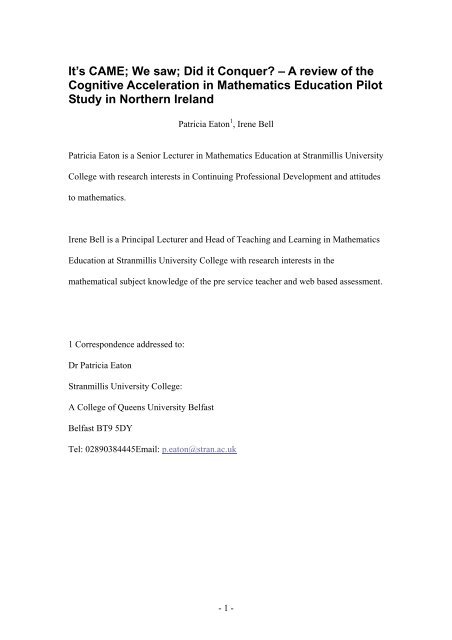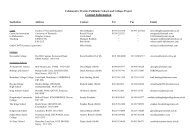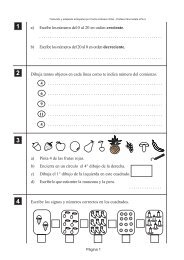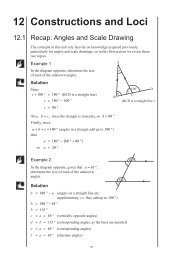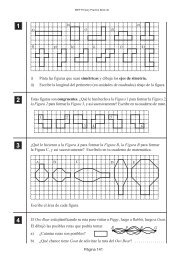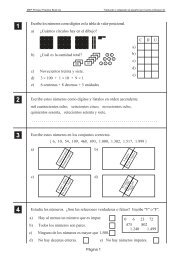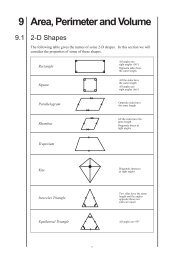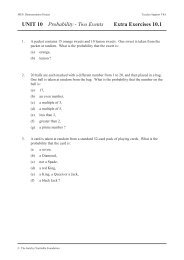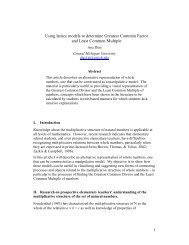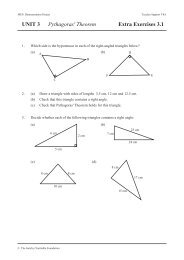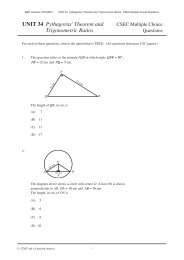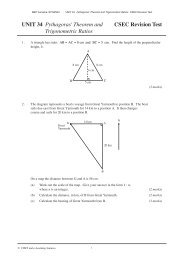It's CAME; We saw; Did it Conquer? – A review of the Cognitive ...
It's CAME; We saw; Did it Conquer? – A review of the Cognitive ...
It's CAME; We saw; Did it Conquer? – A review of the Cognitive ...
You also want an ePaper? Increase the reach of your titles
YUMPU automatically turns print PDFs into web optimized ePapers that Google loves.
It’s <strong>CAME</strong>; <strong>We</strong> <strong>saw</strong>; <strong>Did</strong> <strong>it</strong> <strong>Conquer</strong>? <strong>–</strong> A <strong>review</strong> <strong>of</strong> <strong>the</strong><br />
Cogn<strong>it</strong>ive Acceleration in Ma<strong>the</strong>matics Education Pilot<br />
Study in Nor<strong>the</strong>rn Ireland<br />
Patricia Eaton 1 , Irene Bell<br />
Patricia Eaton is a Senior Lecturer in Ma<strong>the</strong>matics Education at Stranmillis Univers<strong>it</strong>y<br />
College w<strong>it</strong>h research interests in Continuing Pr<strong>of</strong>essional Development and att<strong>it</strong>udes<br />
to ma<strong>the</strong>matics.<br />
Irene Bell is a Principal Lecturer and Head <strong>of</strong> Teaching and Learning in Ma<strong>the</strong>matics<br />
Education at Stranmillis Univers<strong>it</strong>y College w<strong>it</strong>h research interests in <strong>the</strong><br />
ma<strong>the</strong>matical subject knowledge <strong>of</strong> <strong>the</strong> pre service teacher and web based assessment.<br />
1 Correspondence addressed to:<br />
Dr Patricia Eaton<br />
Stranmillis Univers<strong>it</strong>y College:<br />
A College <strong>of</strong> Queens Univers<strong>it</strong>y Belfast<br />
Belfast BT9 5DY<br />
Tel: 02890384445Email: p.eaton@stran.ac.uk<br />
- 1 -
Abstract<br />
This paper presents <strong>the</strong> findings <strong>of</strong> a pilot evaluation funded by <strong>the</strong> Belfast Education<br />
and Library Board <strong>of</strong> <strong>the</strong> Cogn<strong>it</strong>ive Acceleration in Ma<strong>the</strong>matics Education<br />
Programme in a number <strong>of</strong> post-primary schools in Nor<strong>the</strong>rn Ireland. It looks at <strong>the</strong><br />
impact <strong>of</strong> <strong>the</strong> programme on teachers’ classroom practice and teaching methods and<br />
<strong>it</strong>s use as a pr<strong>of</strong>essional development tool. It also examines <strong>the</strong> impact on <strong>the</strong> pupils<br />
in terms <strong>of</strong> performance and att<strong>it</strong>ude to ma<strong>the</strong>matics.<br />
Background<br />
The Cogn<strong>it</strong>ive Acceleration in Ma<strong>the</strong>matics Education Project (<strong>CAME</strong>) project is<br />
funded at King’s College, Univers<strong>it</strong>y <strong>of</strong> London by <strong>the</strong> Esmee Fairburn Char<strong>it</strong>able<br />
trust and <strong>the</strong> Economic and Social Research Council. Thinking Maths (Adhami,<br />
Johnson, & Shayer, 1998) gives a full account <strong>of</strong> <strong>the</strong> project.<br />
The aim <strong>of</strong> <strong>the</strong> <strong>CAME</strong> project is to enhance <strong>the</strong> cogn<strong>it</strong>ive development <strong>of</strong> students<br />
through approaching <strong>the</strong>ir ma<strong>the</strong>matics learning in a reflective way. It builds on <strong>the</strong><br />
work <strong>of</strong> earlier projects in science, for example <strong>the</strong> Cogn<strong>it</strong>ive Acceleration through<br />
Science Project, and <strong>the</strong> successful outcomes <strong>of</strong> such programmes (Adey and Shayer,<br />
1994) provided <strong>the</strong> motivation for developing <strong>CAME</strong>. It is <strong>the</strong>oretically grounded in<br />
<strong>the</strong> dimension <strong>of</strong> social constructivism and draws on <strong>the</strong> work <strong>of</strong> Piaget and<br />
Vygotsky, seeking to integrate <strong>the</strong> cogn<strong>it</strong>ive and social agenda in <strong>the</strong> classroom. In<br />
order to develop a culture <strong>of</strong> thinking and reasoning <strong>it</strong> suggests that attention needs to<br />
be paid to both <strong>the</strong> subject being taught and to how <strong>the</strong> learning is managed. It aims<br />
to contribute particularly to <strong>the</strong> teaching <strong>of</strong> ma<strong>the</strong>matics in early adolescence where <strong>it</strong><br />
is suggested that <strong>the</strong>re is a ‘window <strong>of</strong> opportun<strong>it</strong>y’ for rapid intellectual<br />
development, given appropriate specialist teaching and su<strong>it</strong>able cogn<strong>it</strong>ive stimulation.<br />
It suggests that this approach can significantly raise <strong>the</strong> thinking capac<strong>it</strong>y <strong>of</strong> <strong>the</strong><br />
students and gives weight to cogn<strong>it</strong>ive development as well as topic specific learning.<br />
The <strong>CAME</strong> project has developed a technique <strong>of</strong> teaching ma<strong>the</strong>matics designed to<br />
promote general thinking and recommends a two year programme w<strong>it</strong>h <strong>CAME</strong><br />
lessons being taught approximately every two weeks. The project has produced<br />
- 2 -
comprehensive guidance notes for each lesson, each <strong>of</strong> which has <strong>the</strong> following fourpart<br />
structure:<br />
Phase 1 Phase 2 Phase 3 Phase 4<br />
• Concrete<br />
preparation<br />
• Cogn<strong>it</strong>ive<br />
challenge<br />
• Social<br />
Challenge<br />
- 3 -<br />
• Whole class<br />
construction<br />
• Metacogn<strong>it</strong>ion<br />
• Bridging<br />
The lessons are characterised by group interactions and <strong>the</strong> emphasis is on individual<br />
or group formulations <strong>of</strong> solutions to problems ra<strong>the</strong>r than just on <strong>the</strong> end result. The<br />
outcome <strong>of</strong> <strong>the</strong> lesson is <strong>the</strong> thinking process and <strong>the</strong> sharing <strong>of</strong> ideas ra<strong>the</strong>r than <strong>the</strong><br />
specific knowledge or skills <strong>the</strong>mselves.<br />
Current Climate<br />
It seems that in order to learn, young people need opportun<strong>it</strong>ies to explore<br />
real problems and to think through <strong>the</strong>ir responses, making meaningful<br />
connections and, ideally, making <strong>the</strong>ir own meaning, ra<strong>the</strong>r than being<br />
“taught” solutions or having meaning created for <strong>the</strong>m. The challenge is<br />
<strong>the</strong>refore to make learning developmentally appropriate to <strong>the</strong> age and matur<strong>it</strong>y<br />
<strong>of</strong> <strong>the</strong> learner; socially relevant; emotionally engaging; motivational, in <strong>the</strong><br />
sense <strong>of</strong> being explic<strong>it</strong>ly relevant to real-life contexts; cogn<strong>it</strong>ively challenging;<br />
and connected.<br />
(Pathways, Proposals for Curriculum and Assessment at Key<br />
Stage 3, CEA 2003 Page 2 <strong>of</strong> Rationale)<br />
This extract from <strong>the</strong> proposal for <strong>the</strong> new curriculum in Nor<strong>the</strong>rn Ireland<br />
summarises a move w<strong>it</strong>hin <strong>the</strong> education commun<strong>it</strong>y as a whole towards a more<br />
constructivist view <strong>of</strong> education. Whilst stimulating pupils w<strong>it</strong>h challenging<br />
problems and encouraging <strong>the</strong>m to think has been a cornerstone <strong>of</strong> ma<strong>the</strong>matics<br />
teaching for many years (Polya, 1945) <strong>the</strong>re is still <strong>of</strong>ten a tension between <strong>the</strong><br />
demands <strong>of</strong> preparing pupils for examinations or “covering <strong>the</strong> curriculum” and<br />
allowing pupils opportun<strong>it</strong>ies to make <strong>the</strong>ir own learning connections. The
Activating Children’s Thinking Skills Report (McGuiness et al, 1996 page 62) states<br />
that ma<strong>the</strong>matics teachers experience a problem w<strong>it</strong>h:<br />
a recogn<strong>it</strong>ion <strong>of</strong> <strong>the</strong> conflict between ‘rote’ learning deemed to be<br />
necessary for <strong>the</strong> ‘basics’ and getting through <strong>the</strong> curriculum and<br />
examination work, and on <strong>the</strong> o<strong>the</strong>r hand, investigative learning to<br />
encourage thinking and problem solving.<br />
Schoenfeld (1994) argues that learning to think ma<strong>the</strong>matically means both<br />
developing competence w<strong>it</strong>h <strong>the</strong> tools <strong>of</strong> <strong>the</strong> trade and developing a ma<strong>the</strong>matical<br />
point <strong>of</strong> view or as he puts <strong>the</strong> latter “valuing <strong>the</strong> process <strong>of</strong> ma<strong>the</strong>matisation”. It is<br />
seen as crucial in ma<strong>the</strong>matics education to find a bridge between <strong>the</strong>se two<br />
competing demands in <strong>the</strong> classroom and teachers are being encouraged to champion<br />
<strong>the</strong> cause <strong>of</strong> thinking skills in <strong>the</strong> ma<strong>the</strong>matics classroom (Ball, 2002; Pratt, 2002).<br />
Education System in Nor<strong>the</strong>rn Ireland<br />
While <strong>the</strong> research supporting this paper may have broader implications, <strong>it</strong> was<br />
carried out in Nor<strong>the</strong>rn Ireland and a short overview <strong>of</strong> <strong>the</strong> education system is<br />
provided here to illustrate <strong>the</strong> context. Nor<strong>the</strong>rn Ireland has a population <strong>of</strong><br />
approximately one and a half million w<strong>it</strong>h two hundred and thirty five post-primary<br />
schools and a post-primary pupil population <strong>of</strong> approximately one hundred and fifty<br />
six thousand students (DE, 2004).<br />
Responsibil<strong>it</strong>y for education lies w<strong>it</strong>h <strong>the</strong> Department <strong>of</strong> Education (NI) w<strong>it</strong>h five<br />
Education and Library Boards (ELBs) playing a broadly similar role to LEAs in<br />
England in that <strong>the</strong>y <strong>of</strong>fer support and curriculum advice to teachers. Nor<strong>the</strong>rn<br />
Ireland mostly retains a selective post-primary system w<strong>it</strong>h children s<strong>it</strong>ting a transfer<br />
test at <strong>the</strong> end <strong>of</strong> primary school w<strong>it</strong>h approximately forty per cent attending selective<br />
Grammar schools.<br />
Implementation <strong>of</strong> <strong>CAME</strong> in Nor<strong>the</strong>rn Ireland<br />
The Belfast Education and Library Board (BELB) wanted to introduce a programme<br />
that encouraged <strong>the</strong> move from a didactic to a constructivist approach in <strong>the</strong><br />
ma<strong>the</strong>matics classroom, and to encourage <strong>the</strong> development <strong>of</strong> thinking skills through<br />
<strong>the</strong> delivery <strong>of</strong> <strong>the</strong> ma<strong>the</strong>matics curriculum. It aimed to find a research-based<br />
programme that would facil<strong>it</strong>ate this. In add<strong>it</strong>ion, <strong>the</strong> board wanted a programme that<br />
- 4 -
was practical, su<strong>it</strong>able for a wide range <strong>of</strong> abil<strong>it</strong>ies, and which could be easily<br />
implemented by practising teachers but did not compromise ma<strong>the</strong>matical rigour. It<br />
was also hoped to find a programme that included a pr<strong>of</strong>essional development aspect<br />
for teachers. W<strong>it</strong>h <strong>the</strong>se aims in mind <strong>the</strong> decision was taken to introduce <strong>the</strong> <strong>CAME</strong><br />
project, which was already operating in a number <strong>of</strong> schools in England, into a<br />
number <strong>of</strong> pilot schools in <strong>the</strong> Belfast area.<br />
The programme was launched in June 2002 w<strong>it</strong>h a conference in Belfast that was<br />
attended by heads <strong>of</strong> ma<strong>the</strong>matics departments in post-primary schools, <strong>of</strong>ficers from<br />
<strong>the</strong> BELB, representatives from three o<strong>the</strong>r Education and Library Boards and<br />
members <strong>of</strong> <strong>the</strong> Education and Training Inspectorate Ma<strong>the</strong>matics Team. The<br />
conference was presented by Alan Edmiston, an accred<strong>it</strong>ed <strong>CAME</strong> tutor, and<br />
Mundher Adhami, one <strong>of</strong> <strong>the</strong> founders <strong>of</strong> <strong>the</strong> <strong>CAME</strong> programme in King’s College,<br />
London, and co-author <strong>of</strong> <strong>the</strong> accompanying teachers’ materials.<br />
Four post-primary schools were inv<strong>it</strong>ed by BELB to take part in <strong>the</strong> first year <strong>of</strong> <strong>the</strong><br />
pr<strong>of</strong>essional development programme. Each participating school was asked to<br />
nominate two contact teachers who each undertook to deliver a series <strong>of</strong> <strong>CAME</strong><br />
lessons w<strong>it</strong>h a Year 8 class. Each teacher was given a copy <strong>of</strong> Thinking Maths, <strong>the</strong><br />
teachers’ guide to <strong>the</strong> <strong>CAME</strong> programme. It contains an overview <strong>of</strong> <strong>the</strong><br />
methodology and twenty <strong>CAME</strong> lessons w<strong>it</strong>h lesson notes and resources. The<br />
teachers were also expected to take part in training sessions. These training sessions<br />
took place three times during <strong>the</strong> academic year and were conducted by a <strong>CAME</strong><br />
tutor. The teachers were released from teaching for two days and given <strong>the</strong><br />
opportun<strong>it</strong>y to discuss <strong>the</strong> <strong>CAME</strong> lessons that <strong>the</strong>y had been delivering in school. The<br />
<strong>CAME</strong> tutor taught demonstration lessons in each <strong>of</strong> <strong>the</strong> participating schools and<br />
<strong>the</strong>se were observed and evaluated by <strong>the</strong> group <strong>of</strong> eight teachers. The tutor also made<br />
use <strong>of</strong> video clips to highlight key elements <strong>of</strong> <strong>the</strong> <strong>CAME</strong> approach. Later in <strong>the</strong> year,<br />
each <strong>of</strong> <strong>the</strong> teachers delivered a lesson during <strong>the</strong> training days, which was peer<br />
<strong>review</strong>ed by <strong>the</strong> o<strong>the</strong>r teachers and by <strong>the</strong> <strong>CAME</strong> representative. Between <strong>the</strong><br />
training sessions, teachers were expected to continue delivering a number <strong>of</strong> <strong>CAME</strong><br />
lessons in <strong>the</strong>ir own schools.<br />
- 5 -
At <strong>the</strong> end <strong>of</strong> <strong>the</strong> first academic year, a fur<strong>the</strong>r four schools were inv<strong>it</strong>ed to take part<br />
while <strong>the</strong> existing teachers carried on to <strong>the</strong> second and final year <strong>of</strong> <strong>the</strong> programme.<br />
This research involved <strong>the</strong> first cohort <strong>of</strong> teachers and <strong>the</strong> Year 9 pupils who had<br />
experienced two years <strong>of</strong> <strong>the</strong> <strong>CAME</strong> lessons.<br />
Focus <strong>of</strong> <strong>the</strong> Study<br />
This survey focussed on post-primary schools and collected data from two schools<br />
implementing <strong>the</strong> <strong>CAME</strong> project and two control schools outside <strong>the</strong> project. The<br />
research aimed to examine a number <strong>of</strong> key issues:<br />
The impact <strong>of</strong> <strong>the</strong> <strong>CAME</strong> project on pupils':<br />
• group working skills (to include discussion and teacher/pupil,<br />
pupil/pupil interactions);<br />
• abil<strong>it</strong>y to approach unfamiliar problems (to include both att<strong>it</strong>ude and<br />
technique);<br />
• motivation and confidence in ma<strong>the</strong>matics;<br />
• awareness <strong>of</strong> applicabil<strong>it</strong>y <strong>of</strong> skills outside ma<strong>the</strong>matics.<br />
The impact <strong>of</strong> <strong>the</strong> <strong>CAME</strong> project on teachers':<br />
• teaching methods.<br />
Teachers' perceptions <strong>of</strong> <strong>the</strong> <strong>CAME</strong> project w<strong>it</strong>h particular reference to:<br />
• <strong>it</strong>s su<strong>it</strong>abil<strong>it</strong>y for a full range <strong>of</strong> abil<strong>it</strong>ies;<br />
• <strong>the</strong> transferabil<strong>it</strong>y <strong>of</strong> teaching approaches;<br />
• <strong>the</strong> structure <strong>of</strong> <strong>the</strong> support programme.<br />
Methodology<br />
The Belfast Education and Library Board commissioned this report to <strong>review</strong> <strong>the</strong> first<br />
two years <strong>of</strong> <strong>the</strong> <strong>CAME</strong> project. In add<strong>it</strong>ion to this <strong>review</strong> <strong>the</strong> BELB were particularly<br />
interested in examining <strong>the</strong> academic self-perception <strong>of</strong> those pupils who had<br />
participated in <strong>the</strong> project compared to a control sample who had not.<br />
- 6 -
At <strong>the</strong> end <strong>of</strong> <strong>the</strong> academic year 2003/2004 four schools had completed <strong>the</strong> two year<br />
pilot project. A sample, to participate in <strong>the</strong> pilot study, <strong>of</strong> one grammar school and<br />
one non-grammar school was made by <strong>the</strong> BELB from <strong>the</strong> in<strong>it</strong>ial group <strong>of</strong> four<br />
schools. A control sample <strong>of</strong> two non-<strong>CAME</strong> schools, one grammar and one nongrammar,<br />
was chosen by <strong>the</strong> BELB.<br />
W<strong>it</strong>hin each <strong>of</strong> <strong>the</strong> four schools participating in <strong>the</strong> pilot study, two year 9 classes<br />
were administered <strong>the</strong> ‘Myself as a Learner Standardised Scale’ (MAL) (2002).<br />
Burden (2000) perceives this as an information ga<strong>the</strong>ring instrument and comments<br />
that adolescents have responded pos<strong>it</strong>ively to <strong>the</strong> nature and purpose <strong>of</strong> <strong>it</strong>. The results<br />
were in<strong>it</strong>ially analysed using <strong>the</strong> MAL scale suggested by Burden. Fur<strong>the</strong>r analysis<br />
using <strong>the</strong> Mann-Wh<strong>it</strong>ney U-test was <strong>the</strong>n carried out. This is an inferential nonparametric<br />
test for significance and <strong>it</strong> was deemed appropriate for this data because <strong>of</strong><br />
<strong>it</strong>s su<strong>it</strong>abil<strong>it</strong>y for data w<strong>it</strong>h a small sample size and where <strong>the</strong>re may not be a normal<br />
distribution.<br />
In add<strong>it</strong>ion, each school provided <strong>the</strong> researchers w<strong>it</strong>h a small group <strong>of</strong> approximately<br />
six pupils who participated in a taped group interview. As <strong>the</strong> interviewees were<br />
children <strong>it</strong> was hoped that <strong>the</strong> group interview would be less intimidating and would<br />
encourage a variety <strong>of</strong> ideas and responses. The interview questions were presented in<br />
a standardised semi-structured format.<br />
In <strong>the</strong> two <strong>CAME</strong> schools and <strong>the</strong> two control schools <strong>the</strong> class teachers participated<br />
in a standardised semi-structured taped interview. Prior to recording, <strong>the</strong> teachers<br />
were inv<strong>it</strong>ed to <strong>review</strong> <strong>the</strong> questions and where <strong>the</strong> researchers felt <strong>it</strong> appropriate, <strong>the</strong>y<br />
explored fur<strong>the</strong>r comments and issues raised by <strong>the</strong> teachers’ responses. In add<strong>it</strong>ion,<br />
<strong>the</strong> Head <strong>of</strong> Ma<strong>the</strong>matics in each <strong>of</strong> <strong>the</strong> schools was inv<strong>it</strong>ed to respond to issues<br />
relating to whole school policy matters.<br />
Results<br />
Teaching Methods<br />
The teaching staff in <strong>the</strong> schools participating in <strong>the</strong> <strong>CAME</strong> project felt that <strong>the</strong>ir<br />
teaching methods had been affected pos<strong>it</strong>ively by involvement. The use <strong>of</strong> group<br />
- 7 -
work was discussed w<strong>it</strong>h <strong>the</strong> teachers and <strong>the</strong> view was expressed that in<strong>it</strong>ially <strong>the</strong>ir<br />
own concept <strong>of</strong> what const<strong>it</strong>uted group work had to be examined in order to<br />
accommodate <strong>the</strong> <strong>CAME</strong> lessons. One teacher explained that he had reached <strong>the</strong><br />
opinion that since <strong>the</strong> children ‘spend more time during <strong>the</strong> day speaking to <strong>the</strong>ir<br />
friends and value <strong>the</strong> opinions <strong>of</strong> <strong>the</strong>ir peers, <strong>the</strong>n <strong>the</strong> use <strong>of</strong> discussion w<strong>it</strong>hin <strong>the</strong><br />
groups was just a logical step forward’. Concerns that allowing children to participate<br />
in this format <strong>of</strong> learning was a form <strong>of</strong> ‘cheating’, that <strong>the</strong> group would be<br />
dominated by strong personal<strong>it</strong>ies or that <strong>the</strong> weaker students would become isolated<br />
proved to be unfounded once <strong>the</strong> <strong>CAME</strong> approach had been introduced. The <strong>CAME</strong><br />
teachers discussed how <strong>the</strong> use <strong>of</strong> group work allowed peer tutoring to come into<br />
play, w<strong>it</strong>h <strong>the</strong> less able children ‘picking up qu<strong>it</strong>e quickly what <strong>the</strong> o<strong>the</strong>r children are<br />
talking about’ and <strong>the</strong> children ‘enjoying <strong>the</strong> chance to help each o<strong>the</strong>r’.<br />
The area <strong>of</strong> student confidence and anxiety was introduced by <strong>the</strong> <strong>CAME</strong> teachers in<br />
discussing <strong>the</strong>ir use <strong>of</strong> group work. The teachers discussed how children understood<br />
that all <strong>of</strong> <strong>the</strong> responses from a group would be accepted by <strong>the</strong> teacher and treated<br />
equally. In establishing which responses were correct, <strong>the</strong> teachers had <strong>the</strong><br />
opportun<strong>it</strong>y to use incorrect responses to fur<strong>the</strong>r stretch <strong>the</strong> thinking <strong>of</strong> <strong>the</strong> children<br />
and allow <strong>the</strong>m to argue <strong>the</strong> case for <strong>the</strong> correct answer. The teachers felt this was a<br />
pos<strong>it</strong>ive aspect <strong>of</strong> this teaching strategy. All <strong>of</strong> <strong>the</strong> teachers involved in <strong>the</strong> <strong>CAME</strong><br />
project felt that allowing <strong>the</strong> children to take more ownership increased <strong>the</strong> pupils’<br />
confidence. The improvement in <strong>the</strong> pupils’ ma<strong>the</strong>matical confidence materialised not<br />
only in <strong>the</strong>ir enjoyment and willingness to participate in <strong>the</strong> lessons but also in <strong>the</strong>ir<br />
style <strong>of</strong> questioning. The opinion was voiced that <strong>the</strong> phrase ‘I can’t do that’ was<br />
being frequently replaced w<strong>it</strong>h ‘I have got as far as …and now I am stuck’. The<br />
<strong>CAME</strong> teachers interpreted this as children having sufficient confidence in <strong>the</strong>ir<br />
ma<strong>the</strong>matical abil<strong>it</strong>y to be able to break down a question into <strong>it</strong>s component elements<br />
and thus be able to isolate <strong>the</strong> areas that were causing <strong>the</strong>m difficulty.<br />
Associated w<strong>it</strong>h <strong>the</strong> use <strong>of</strong> group work, <strong>the</strong> areas <strong>of</strong> classroom management, discipline<br />
and time allocation were discussed by both <strong>the</strong> <strong>CAME</strong> and non-<strong>CAME</strong> teachers. In<br />
terms <strong>of</strong> classroom management both sets <strong>of</strong> teachers had concerns about <strong>the</strong><br />
manageabil<strong>it</strong>y <strong>of</strong> group work. The teachers identified <strong>the</strong> following external factors:<br />
class duration and size, arranging furn<strong>it</strong>ure to accommodate <strong>the</strong> style <strong>of</strong> teaching and<br />
- 8 -
curricula demands. However, <strong>the</strong> view was expressed by some <strong>of</strong> <strong>the</strong> <strong>CAME</strong> teachers<br />
that <strong>the</strong> <strong>CAME</strong> approach put a structure onto group work and <strong>the</strong>refore once that<br />
approach had been established, <strong>the</strong> discipline issues did not arise. They did contrast<br />
<strong>the</strong> <strong>the</strong>oretical classroom management s<strong>it</strong>uations portrayed on <strong>the</strong> training videos<br />
against <strong>the</strong> everyday real<strong>it</strong>y and felt that in this aspect some <strong>of</strong> <strong>the</strong> classroom<br />
scenarios were not realistic. W<strong>it</strong>hin both <strong>the</strong> <strong>CAME</strong> and non-<strong>CAME</strong> schools <strong>the</strong><br />
formation <strong>of</strong> groups occurred in different ways; <strong>the</strong> structure <strong>of</strong> groups that appeared<br />
to be favoured was that <strong>of</strong> mixed abil<strong>it</strong>y. This not only allowed peer-tutoring to occur<br />
but also perm<strong>it</strong>ted <strong>the</strong> less enthusiastic pupils to w<strong>it</strong>ness <strong>the</strong> pleasure w<strong>it</strong>h which o<strong>the</strong>r<br />
members <strong>of</strong> <strong>the</strong> class worked. <strong>CAME</strong> teachers did express concern that <strong>the</strong> approach<br />
was time consuming and that ‘<strong>it</strong> can be frustrating if you have certain areas in <strong>the</strong><br />
curriculum to be covered and <strong>the</strong> discussion has led in a different direction’. None <strong>of</strong><br />
<strong>the</strong> <strong>CAME</strong> teachers interviewed found sufficient time to teach all <strong>the</strong> lessons<br />
recommended in <strong>the</strong> <strong>CAME</strong> teachers’ guide or at <strong>the</strong> training sessions. The teachers<br />
expressed <strong>the</strong> view that preparing children for e<strong>it</strong>her internal or external examinations<br />
was an influencing factor in not achieving <strong>the</strong> desired number <strong>of</strong> lessons.<br />
The su<strong>it</strong>abil<strong>it</strong>y <strong>of</strong> <strong>the</strong> <strong>CAME</strong> material for different abil<strong>it</strong>y ranges<br />
In discussing <strong>the</strong> su<strong>it</strong>abil<strong>it</strong>y <strong>of</strong> <strong>the</strong> <strong>CAME</strong> material for all abil<strong>it</strong>y ranges, <strong>the</strong> teachers<br />
felt that <strong>the</strong> ‘middle abil<strong>it</strong>y ma<strong>the</strong>maticians would understand a lot <strong>of</strong> <strong>it</strong>’ and that <strong>the</strong><br />
material was ‘p<strong>it</strong>ched round about <strong>the</strong>ir level’. The teachers in <strong>the</strong> grammar school<br />
expressed <strong>the</strong> opinion that <strong>the</strong>ir ‘bright’ children would be able to work through <strong>the</strong><br />
material quickly although <strong>the</strong>y felt that this group <strong>of</strong> children would be able to<br />
transfer <strong>the</strong> skills and knowledge <strong>the</strong>y had learnt into o<strong>the</strong>r subject areas. The teachers<br />
in <strong>the</strong> non-<strong>CAME</strong> schools, both grammar and non-grammar, did not feel that even<br />
<strong>the</strong>ir brighter pupils would be able to do this. One teacher also articulated <strong>the</strong> view<br />
that sometimes his best ma<strong>the</strong>maticians were also his quieter children in class and that<br />
<strong>the</strong> <strong>CAME</strong> approach had given <strong>the</strong>m an opportun<strong>it</strong>y to articulate <strong>the</strong>ir ma<strong>the</strong>matics<br />
and gain confidence in expressing <strong>the</strong>ir views in class. Ano<strong>the</strong>r teacher felt that<br />
although <strong>the</strong> <strong>CAME</strong> material was useable for <strong>the</strong> weaker student, <strong>it</strong> became very time<br />
consuming because <strong>the</strong> pupils’ weak ma<strong>the</strong>matical knowledge meant that establishing<br />
accurate knowledge took a long time. This teacher felt that <strong>the</strong> teacher guidance<br />
needed by <strong>the</strong>se pupils contradicted <strong>the</strong> ethos <strong>of</strong> <strong>the</strong> <strong>CAME</strong> ideal.<br />
- 9 -
Transferabil<strong>it</strong>y <strong>of</strong> Teaching Skills<br />
In general <strong>the</strong> <strong>CAME</strong> teachers felt that as a result <strong>of</strong> participating in <strong>the</strong> project <strong>the</strong>y<br />
had <strong>the</strong> opportun<strong>it</strong>y to develop certain pr<strong>of</strong>essional aspects <strong>of</strong> <strong>the</strong>ir work that<br />
o<strong>the</strong>rwise would not have taken place. In particular <strong>the</strong> teachers discussed <strong>the</strong><br />
questioning techniques that had played such a major role in this work. Some<br />
expressed <strong>the</strong> view that in<strong>it</strong>ially, having asked a question, <strong>the</strong>y found <strong>the</strong> silence<br />
which occurred while wa<strong>it</strong>ing for a pupil response difficult to handle. The tendency to<br />
‘give <strong>the</strong> answer’ or rephrase <strong>the</strong> question was almost natural and <strong>the</strong>y had to learn to<br />
hold back and let <strong>the</strong> pupils in<strong>it</strong>iate <strong>the</strong> reply. However, this was a learning experience<br />
for both pupil and teacher. All <strong>of</strong> <strong>the</strong> teachers expressed <strong>the</strong> view that <strong>the</strong>y had<br />
brought this new style <strong>of</strong> questioning and classroom management into o<strong>the</strong>r classes<br />
throughout <strong>the</strong> school that were not involved in <strong>the</strong> project. Teachers felt that <strong>the</strong><br />
<strong>CAME</strong> approach could be useful in preparing older pupils to approach coursework for<br />
GCSE.<br />
All <strong>of</strong> <strong>the</strong> <strong>CAME</strong> teachers felt that <strong>the</strong> material used in <strong>the</strong> project as well as <strong>the</strong><br />
suggested approach, encouraged children to develop <strong>the</strong>ir thinking skills. In general,<br />
thinking skills were not taught ‘in <strong>the</strong>ir own right’. Ne<strong>it</strong>her <strong>CAME</strong>, nor non-<strong>CAME</strong><br />
teachers felt that <strong>the</strong>re was much support for <strong>the</strong> opinion that children could transfer<br />
<strong>the</strong>ir thinking skills into o<strong>the</strong>r areas <strong>of</strong> <strong>the</strong> curriculum. In general, <strong>the</strong> teachers thought<br />
that pupils viewed ma<strong>the</strong>matics as a separate ent<strong>it</strong>y. Examples that contradicted this<br />
would include <strong>the</strong> obvious use <strong>of</strong> calculation or graphical work w<strong>it</strong>hin Science,<br />
Geography or Technology.<br />
One <strong>of</strong> <strong>the</strong> schools participating in <strong>the</strong> <strong>CAME</strong> project organised an in-house training<br />
day for <strong>the</strong>ir teachers from all subject areas. The purpose <strong>of</strong> this was to demonstrate<br />
<strong>the</strong> <strong>CAME</strong> style <strong>of</strong> teaching and to suggest ways in which o<strong>the</strong>r subjects could use<br />
this. They expressed <strong>the</strong> view that <strong>the</strong>re was a ‘generally pos<strong>it</strong>ive att<strong>it</strong>ude’ and ‘group<br />
inclusiveness’ about <strong>the</strong> approach that <strong>the</strong>y felt would be good practice w<strong>it</strong>hin <strong>the</strong><br />
school.<br />
- 10 -
The Structure <strong>of</strong> <strong>the</strong> Support Programme<br />
The teachers involved in <strong>the</strong> <strong>CAME</strong> project felt that on <strong>it</strong>s own, <strong>the</strong> resource folder<br />
was ‘very intimidating’ and that <strong>the</strong> folder gave ‘hints’ on how to approach a lesson.<br />
The <strong>CAME</strong> teachers felt that w<strong>it</strong>hout training, <strong>the</strong> material in <strong>the</strong> folder would<br />
probably be interpreted as just ano<strong>the</strong>r investigation. The training videos were<br />
described as ‘crucial’ in indicating <strong>the</strong> style <strong>of</strong> a <strong>CAME</strong> lesson and watching ano<strong>the</strong>r<br />
colleague present some <strong>of</strong> <strong>the</strong>se lessons was also c<strong>it</strong>ed as being very beneficial.<br />
However, <strong>it</strong> was commented upon that <strong>the</strong> classroom management <strong>of</strong> <strong>the</strong> videoed<br />
lessons was slightly artificial and <strong>the</strong> view was expressed that more time could have<br />
been spent discussing <strong>the</strong> real<strong>it</strong>ies involved in implementing <strong>the</strong>se lessons. There were<br />
differences <strong>of</strong> opinion about <strong>the</strong> training days. These ranged from being described as<br />
‘very good’, w<strong>it</strong>h particular enthusiasm for <strong>the</strong> collegial<strong>it</strong>y and support from o<strong>the</strong>r<br />
participating teachers, to ‘less beneficial’ and repet<strong>it</strong>ive.<br />
Pupils’ Motivation and Confidence in Ma<strong>the</strong>matics<br />
Pupils in both <strong>CAME</strong> and non-<strong>CAME</strong> schools were asked about <strong>the</strong>ir feelings<br />
towards ma<strong>the</strong>matics and most expressed <strong>the</strong> view that <strong>it</strong> is a hard subject, is boring<br />
and consists <strong>of</strong> too much work. One pupil in a <strong>CAME</strong> school described ma<strong>the</strong>matics<br />
as fun while a few o<strong>the</strong>r pupils at <strong>the</strong> same school talked about <strong>the</strong> enjoyment to be<br />
had solving problems and discussing ma<strong>the</strong>matics in a group. This view point was<br />
not exclusive to <strong>the</strong> <strong>CAME</strong> pupils. Areas <strong>of</strong> ma<strong>the</strong>matics that emerged as being most<br />
enjoyable were calculator work, formulas, symmetry, circles, probabil<strong>it</strong>y and pie<br />
charts.<br />
Pupils’ abil<strong>it</strong>y to approach unfamiliar problems<br />
When asked about how <strong>the</strong>y would approach an unfamiliar ma<strong>the</strong>matics problem <strong>the</strong><br />
<strong>CAME</strong> pupils responded that <strong>the</strong>y would try to work <strong>it</strong> out for <strong>the</strong>mselves before<br />
asking <strong>the</strong> teacher, w<strong>it</strong>h several pupils suggesting that <strong>the</strong>y would try to find an<br />
example <strong>of</strong> a similar type in <strong>the</strong>ir books or try a question w<strong>it</strong>h easier numbers. Most<br />
<strong>of</strong> <strong>the</strong> non-<strong>CAME</strong> pupils said that asking <strong>the</strong> teacher would be <strong>the</strong>ir first recourse.<br />
- 11 -
Pupils’ group working skills<br />
There was no difference in responses from <strong>CAME</strong> and non-<strong>CAME</strong> pupils to questions<br />
relating to this area. Most pupils indicated that <strong>the</strong>y preferred working in groups<br />
ra<strong>the</strong>r than working on <strong>the</strong>ir own w<strong>it</strong>h only one or two dissenting voices. Reasons for<br />
preferring collaborative working included understanding friends’ explanations better<br />
than a teachers’ explanations, having less work to do in a group and having people to<br />
talk to about <strong>the</strong> work. Some also suggested that <strong>it</strong> provided useful feedback in that<br />
‘your friends could let you know quickly if you had made a mistake’ ra<strong>the</strong>r than<br />
wa<strong>it</strong>ing until <strong>the</strong> teacher was correcting <strong>the</strong> work. Those who preferred working on<br />
<strong>the</strong>ir own said that <strong>it</strong> was faster and that occasionally disagreements arose in a group<br />
s<strong>it</strong>uation.<br />
Pupils’ awareness <strong>of</strong> applicabil<strong>it</strong>y <strong>of</strong> skills outside ma<strong>the</strong>matics<br />
All pupils were aware that some ma<strong>the</strong>matics was useful outside <strong>the</strong> ma<strong>the</strong>matics<br />
classroom. The sciences were highlighted as subjects in which ma<strong>the</strong>matics had a<br />
major role to play and several students drew attention to <strong>the</strong> importance <strong>of</strong> handling<br />
money and dealing w<strong>it</strong>h percentages in everyday life. O<strong>the</strong>rs suggested that topics<br />
like Pythagoras’ Theorem were a waste <strong>of</strong> time as <strong>the</strong>y would not be used elsewhere.<br />
The NFER Survey<br />
The NFER Myself as a Learner Scale (MALS) (Burden, 2000) was used to determine<br />
<strong>the</strong> academic self-perceptions <strong>of</strong> <strong>the</strong> Year 9 pupils. The scale was constructed to<br />
focus on students’ perceptions <strong>of</strong> <strong>the</strong>mselves as learners and active problem-solvers<br />
w<strong>it</strong>hin educational settings and thus seemed to be appropriate to measure <strong>the</strong> impact<br />
that <strong>the</strong> <strong>CAME</strong> project had on student participants.<br />
A sample <strong>of</strong> students from each school was asked to respond to <strong>the</strong> list <strong>of</strong> twenty<br />
statements, shown in Table 3.1, by circling one <strong>of</strong> five possible responses ranging<br />
from (a) Yes, defin<strong>it</strong>ely, to (e) No, defin<strong>it</strong>ely not. Scores were allocated to each <strong>it</strong>em on<br />
a basis <strong>of</strong> 1 (most negative) to 5 (most pos<strong>it</strong>ive) and a total calculated for each<br />
student, <strong>the</strong>reby producing a score for each pupil in <strong>the</strong> range 20 to 100. The mean<br />
- 12 -
score for pupils in <strong>CAME</strong> schools was 67.18 while for those students in non-<strong>CAME</strong><br />
schools <strong>it</strong> was slightly lower at 66.72.<br />
The percentage responses were <strong>the</strong>n calculated for each question and this is shown in<br />
Table 3.1.<br />
The results were subjected to fur<strong>the</strong>r analysis using <strong>the</strong> Mann-Wh<strong>it</strong>ney U-test. It can<br />
be observed from <strong>the</strong> table that 28.3% <strong>of</strong> <strong>CAME</strong> pupils and 17.3% <strong>of</strong> <strong>the</strong> non-<strong>CAME</strong><br />
pupils replied Yes, defin<strong>it</strong>ely or Yes, a b<strong>it</strong> to <strong>the</strong> statement “I like having problems to<br />
solve” and Mann-Wh<strong>it</strong>ney suggests that this is a significant difference (U = 903, p =<br />
0.033).<br />
While no o<strong>the</strong>r statements produced a statistically significant difference between<br />
<strong>CAME</strong> and non-<strong>CAME</strong> respondents <strong>it</strong> is interesting none<strong>the</strong>less to examine <strong>the</strong><br />
results fur<strong>the</strong>r. It can be observed from <strong>the</strong> table that, for example, 37.7% <strong>of</strong> <strong>CAME</strong><br />
pupils replied Yes, defin<strong>it</strong>ely or Yes, a b<strong>it</strong> to <strong>the</strong> statement “I think that problem<br />
solving is fun” as opposed to 28.2% <strong>of</strong> <strong>the</strong> non-<strong>CAME</strong> pupils. In response to <strong>the</strong><br />
statement “I like having difficult work to do”, 15% <strong>of</strong> <strong>CAME</strong> pupils responded<br />
pos<strong>it</strong>ively, that is, responded e<strong>it</strong>her Yes, defin<strong>it</strong>ely, or Yes, a b<strong>it</strong> while 8.7% <strong>of</strong> non-<br />
<strong>CAME</strong> pupils responded pos<strong>it</strong>ively. In <strong>the</strong> same question, 45.3% <strong>of</strong> <strong>CAME</strong> pupils<br />
responded negatively i.e. replied e<strong>it</strong>her Not very true or No, defin<strong>it</strong>ely not while <strong>the</strong><br />
corresponding figure for non-<strong>CAME</strong> pupils was 63%.<br />
The statement “I get anxious when I have to do new work” prompted 18.8% <strong>of</strong><br />
<strong>CAME</strong> pupils and 8.7% <strong>of</strong> non-<strong>CAME</strong> pupils to respond Yes, defin<strong>it</strong>ely or Yes, a b<strong>it</strong>,<br />
and 60.4% <strong>of</strong> <strong>CAME</strong> pupils and 47.9% <strong>of</strong> non-<strong>CAME</strong> pupils to respond e<strong>it</strong>her Not<br />
very true or No, defin<strong>it</strong>ely not.<br />
Considering <strong>the</strong> emphasis in <strong>the</strong> <strong>CAME</strong> project on collaborative problem solving one<br />
might have expected <strong>the</strong>re to be a difference between <strong>CAME</strong> and non-<strong>CAME</strong> pupils<br />
in <strong>the</strong>ir responses to <strong>the</strong> statements “I’m good at discussing things”, “I’m not very<br />
good at solving problems” and “I know how to solve <strong>the</strong> problems I meet”, however<br />
l<strong>it</strong>tle difference between <strong>the</strong> two categories was noted. Among possible explanations<br />
- 13 -
for this is <strong>the</strong> fact that most teachers did not have <strong>the</strong> opportun<strong>it</strong>y to carry out <strong>the</strong><br />
recommended number <strong>of</strong> <strong>CAME</strong> lessons.<br />
In terms <strong>of</strong> encouraging independent learning, <strong>it</strong> is interesting to note that 58.5% <strong>of</strong><br />
<strong>CAME</strong> pupils responded pos<strong>it</strong>ively to <strong>the</strong> statement “When I get stuck w<strong>it</strong>h my work,<br />
I can usually work out what to do next” while <strong>the</strong> figure for non- <strong>CAME</strong> pupils<br />
responding pos<strong>it</strong>ively was 41.3%. Likewise only 11.3% <strong>of</strong> <strong>CAME</strong> pupils agreed to<br />
some degree w<strong>it</strong>h <strong>the</strong> statement “I find a lot <strong>of</strong> schoolwork difficult” while 21.7% <strong>of</strong><br />
non-<strong>CAME</strong> pupils agreed and in response to <strong>the</strong> statement “Learning is difficult”<br />
64.1% <strong>of</strong> <strong>CAME</strong> pupils and 47.8% <strong>of</strong> non <strong>–</strong><strong>CAME</strong> pupils replied e<strong>it</strong>her Not very true<br />
or No, defin<strong>it</strong>ely not.<br />
- 14 -
Table 1.1 Percentages responses for each question by <strong>CAME</strong> (N = 53) and Non-<br />
<strong>CAME</strong> (N = 46) respondents.<br />
<strong>CAME</strong> vs Non-<strong>CAME</strong><br />
1. I’m good at doing<br />
tests<br />
2. I like having<br />
problems to solve.*<br />
3. When I’m given<br />
work to do, I usually<br />
feel confident I can do <strong>it</strong><br />
4. Thinking carefully<br />
about your work helps<br />
you to do <strong>it</strong> better<br />
5. I’m good at<br />
discussing things<br />
6. I need lots <strong>of</strong> help<br />
w<strong>it</strong>h my work<br />
7. I like having difficult<br />
work to do<br />
8. I get anxious when I<br />
have to do new work<br />
9. I think that problem<br />
solving is fun<br />
10. When I get stuck<br />
w<strong>it</strong>h my work, I can<br />
usually work out what<br />
to do next.<br />
Yes, Yes, a b<strong>it</strong> Not sure Not very No,<br />
defin<strong>it</strong>ely<br />
true defin<strong>it</strong>ely<br />
not<br />
C NC C NC C NC C NC C NC<br />
11.3 4.3 34.0 39.1 43.4 34.8 9.4 6.5 1.9 15.2<br />
9.4 4.3 18.9 13.0 41.5 26.1 15.1 32.6 15.1 21.7<br />
11.3 13.0 37.7 34.8 32.1 34.8 13.2 10.9 3.8 4.3<br />
49.1 39.1 41.5 52.2 9.4 6.5 0.0 0.0 0.0 2.2<br />
22.6 26.1 35.8 32.6 24.5 21.7 11.3 13.0 5.7 6.5<br />
3.8 4.3 9.4 6.5 17.0 21.7 52.8 32.6 17.0 34.8<br />
7.5 2.2 7.5 6.5 35.8 28.3 20.8 30.4 24.5 32.6<br />
7.5 0.0 11.3 8.7 20.8 43.5 34.0 28.3 26.4 19.6<br />
11.3 6.5 26.4 21.7 24.5 17.4 26.4 30.4 9.4 21.7<br />
11.3 6.5 47.2 34.8 28.3 34.8 9.4 21.7 3.8 2.2<br />
11. Learning is easy 11.3 6.5 30.2 32.6 24.0 43.5 13.2 6.5 11.3 10.9<br />
12. I’m not very good at<br />
solving problems.<br />
13. I know <strong>the</strong> meaning<br />
<strong>of</strong> a lot <strong>of</strong> words<br />
5.7 8.7 9.4 8.7 24.5 32.6 41.5 39.1 11.3 10.9<br />
17.0 21.7 41.5 45.7 26.4 19.6 7.5 13.0 5.7 0.0<br />
- 15 -
14. I usually think<br />
carefully about what<br />
I’ve got to do.<br />
15. I know how to solve<br />
<strong>the</strong> problems that I<br />
meet.<br />
16. I find a lot <strong>of</strong><br />
schoolwork difficult.<br />
17.0 17.4 39.6 45.7 26.4 26.1 13.2 8.7 1.9 2.2<br />
5.7 2.2 41.5 47.8 30.2 45.7 18.9 4.3 3.8 0.0<br />
3.8 6.5 7.5 15.2 26.4 30.4 34.0 37.0 24.5 10.9<br />
17. I’m clever. 18.9 19.6 45.3 34.8 20.8 30.4 11.3 8.7 3.8 6.5<br />
18. I know how to be a<br />
good learner.<br />
15.1 21.7 45.3 43.5 26.4 26.1 9.4 4.3 3.8 4.3<br />
19. I like using my brain 20.8 21.7 37.7 21.7 26.4 30.4 9.4 13.0 5.7 13.0<br />
20. Learning is difficult 3.8 6.5 9.4 6.5 22.6 39.1 35.8 34.8 28.3 13.0<br />
*Items where a statistically significant difference exists between <strong>the</strong> two independent variables using<br />
Mann Wh<strong>it</strong>ney U.<br />
Conclusion<br />
All <strong>of</strong> <strong>the</strong> staff participating in <strong>the</strong> <strong>CAME</strong> pilot project felt that <strong>the</strong>ir willingness and<br />
abil<strong>it</strong>y to include group work in <strong>the</strong>ir teaching had been pos<strong>it</strong>ively influenced by <strong>the</strong>ir<br />
participation and training in <strong>the</strong> project. The <strong>CAME</strong> teachers paid particular attention<br />
to <strong>the</strong> classroom management <strong>of</strong> this style <strong>of</strong> teaching and had <strong>the</strong> opportun<strong>it</strong>y to<br />
reflect on <strong>the</strong>ir questioning techniques. The <strong>CAME</strong> teachers found that <strong>the</strong>ir new<br />
teaching skills were transferable into o<strong>the</strong>r year groups. All <strong>of</strong> <strong>the</strong> <strong>CAME</strong> teachers<br />
expressed <strong>the</strong> view that <strong>the</strong> <strong>CAME</strong> approach and material would help develop <strong>the</strong><br />
thinking skills <strong>of</strong> <strong>the</strong> pupils, and <strong>the</strong>re is some lim<strong>it</strong>ed evidence <strong>of</strong> this in <strong>the</strong> pupil<br />
interview responses.<br />
Among <strong>the</strong> teachers <strong>the</strong>re seemed to be agreement that <strong>the</strong> <strong>CAME</strong> material was most<br />
su<strong>it</strong>able for pupils broadly in <strong>the</strong> middle ground w<strong>it</strong>h regards to abil<strong>it</strong>y. While<br />
teachers felt that <strong>the</strong> material could be used for <strong>the</strong> weaker pupils <strong>the</strong> difficulty arose<br />
in <strong>the</strong> length <strong>of</strong> time <strong>it</strong> took to cover one lesson. The view was also expressed by<br />
teachers that <strong>the</strong> ma<strong>the</strong>matically able children in <strong>the</strong> grammar sector would find this<br />
material less challenging.<br />
Never<strong>the</strong>less, teachers recognised <strong>the</strong> pos<strong>it</strong>ive aspects <strong>of</strong> peer-tutoring that took place<br />
w<strong>it</strong>hin a mixed abil<strong>it</strong>y group <strong>of</strong> pupils and felt that this was a constructive element <strong>of</strong><br />
- 16 -
this teaching style. This pos<strong>it</strong>ive view <strong>of</strong> peer-tutoring was also reflected in <strong>the</strong> pupil<br />
evidence and both <strong>the</strong> survey and <strong>the</strong> pupil interviews suggested that <strong>the</strong> <strong>CAME</strong><br />
project may have a pos<strong>it</strong>ive influence in encouraging independent working. There<br />
was a statistically significant difference in <strong>the</strong> responses <strong>of</strong> pupils to <strong>the</strong> statement<br />
concerning <strong>the</strong> enjoyment <strong>of</strong> solving problems, w<strong>it</strong>h <strong>CAME</strong> pupils responding more<br />
pos<strong>it</strong>ively.<br />
In <strong>the</strong> view <strong>of</strong> <strong>the</strong> <strong>CAME</strong> teachers, <strong>the</strong> support programme was crucial to this project<br />
as on <strong>it</strong>s own <strong>the</strong> resource folder was intimidating. The demonstration lessons, while<br />
interesting and informative, were at times artificial. However, <strong>the</strong> mutual support<br />
given by <strong>the</strong> participating staff and <strong>the</strong> forum that <strong>the</strong> training days supplied to discuss<br />
difficulties, proved to be very beneficial and appreciated by all who attended.<br />
Broader Application<br />
While this research has highlighted a number <strong>of</strong> very specific issues associated w<strong>it</strong>h<br />
this particular programme <strong>it</strong> also raises a number if issues that are more general. In<br />
particular, <strong>it</strong> raises questions about <strong>the</strong> level and nature <strong>of</strong> integration <strong>of</strong> thinking<br />
skills and cogn<strong>it</strong>ive development into <strong>the</strong> curriculum and gives a glimpse <strong>of</strong> how this<br />
might successfully be accomplished. Certainly <strong>the</strong> ideas underpinning <strong>CAME</strong> can be<br />
heard resonating through <strong>the</strong> new curriculum in Nor<strong>the</strong>rn Ireland and elsewhere. The<br />
change in att<strong>it</strong>ude experienced by <strong>the</strong> pupils w<strong>it</strong>h particular regard to enjoyment <strong>of</strong><br />
problem solving, indicates <strong>the</strong> need for this type <strong>of</strong> work to become more widespread.<br />
In add<strong>it</strong>ion, this research brings to light some concerns about <strong>the</strong> nature <strong>of</strong> continuing<br />
development (CPD) for practising teachers and <strong>the</strong> fact that <strong>the</strong> teachers gained so<br />
much from <strong>the</strong> opportun<strong>it</strong>y to watch each o<strong>the</strong>r teach and discuss <strong>the</strong>ir experiences<br />
suggests that this type <strong>of</strong> CPD has some benef<strong>it</strong> regardless <strong>of</strong> <strong>the</strong> particular aim <strong>of</strong> <strong>the</strong><br />
teaching programme.<br />
- 17 -
References<br />
Adey, P., & Shayer, M. (1994) Really Raising Standards London: Routledge<br />
Adhami, M., Johnson, D.C., & Shayer, M. (1998) Thinking Maths: <strong>the</strong> programme for<br />
Accelerated Learning in Ma<strong>the</strong>matics. Oxford: Heinemann Educational Books.<br />
Ball, B. (2002) What is ma<strong>the</strong>matical thinking? Ma<strong>the</strong>matics Teaching, 181, 17-19.<br />
Burden, R. (2000) Myself as a Learner Scale NFER-Nelson<br />
CEA (2003) Pathways, Proposals for Curriculum and Assessment at Key Stage 3<br />
CEA, Belfast<br />
DE (2004) Facts and Figures accessed January 2005, Department <strong>of</strong> Education<br />
Nor<strong>the</strong>rn Ireland http:www.deni.gov.uk.<br />
McGuiness et al. (1996) Activating Children’s Thinking Skills CCEA, Belfast<br />
Pratt, N. (2002) Ma<strong>the</strong>matics as Thinking, Ma<strong>the</strong>matics Teaching, 181, 34-37.<br />
Schoenfeld, A.H. (1994) Ma<strong>the</strong>matical Thinking and Problem Solving. Hillsdale:<br />
Erlbaum.<br />
- 18 -


